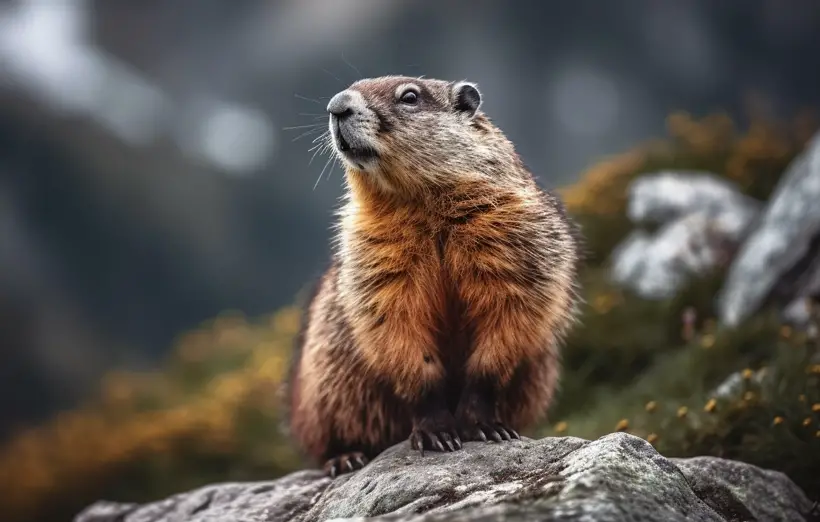Are Marmots Friendly? Understanding Marmot Behavior and Temperament
Marmots are fluffy, ground-dwelling rodents known for their piercing whistle and adorable appearance. But despite their cute and cuddly appearance, many hikers and campers wonder whether marmots are friendly animals.
So, are marmots friendly? The answer is not straightforward. While marmots may appear cute and harmless, their behavior can be unpredictable. In general, marmots are not aggressive toward humans, but they can become territorial if they feel threatened.
Understanding marmot behavior and temperament is key to enjoying these playful creatures’ activities. In this article, we’ll dive deeper into marmot behavior, including their habitat and social structure.
Social Behavior of Marmots
Marmots are medium-sized ground squirrels found in North America and Eurasia. They have great similarities to groundhogs in terms of appearance.
- Marmots are known for their social behavior, living in groups or colonies ranging from a few individuals to hundreds.
- They are generally friendly and curious animals, but their behavior can vary depending on the species and the situation.
- They are diurnal, meaning they are active during the day and rest at night.

Different marmot species exhibit varying levels of social behavior. For example,
- The yellow-bellied marmot of North America is highly social and lives in large colonies.
- Conversely, the alpine marmot of Eurasia lives in smaller groups or pairs.
- The Himalayan marmot, found in Asia, is also highly social and forms large colonies which consist of multiple families.
- Mating in marmots typically occurs between April and May.
- Females give birth to litters of 2-8 pups around June or July. The pups show typical mammal behavior.
However, there are effects of tourists on their reproduction. Have a look at this marmot behavior chart.

Marmot’s social behavior also changes with the seasons, which is a common wildlife behavior. During the summer, when food is plentiful, marmots spend more time socializing, mating, and raising their young.
However, during the winter, when food is scarce, they hibernate and become less social, spending most of their time in their burrows.
Marmot Body Language
Communication plays an essential role in the marmot’s social behavior. They use various vocalizations, different postures, scent markings, and other body languages to communicate.

Posture: A Key Indicator of Marmot Behavior
Marmot posture is a critical indicator of their behavior and temperament. When marmots stand tall on their hind legs with their front paws hanging down, they are usually on alert and trying to detect potential threats.
A whistle accompanies such posture at times, which is used to alert other members of potential threats.
Vocalizations: Marmots’ Language of Communication
Marmots use a range of vocalizations to communicate with each other, including barks, whistles, and trills. These calls can signal potential danger, aggression, or communication during mating season.
Scent Marking: A Unique Way of Communication in Marmots
Some marmots like yellow-bellied ones, use their perioral glands to leave a scent trail that other marmots can follow. This helps them navigate their environment and find their way back to their burrows.
Alpine marmots rub their cheeks in order to scent mark their territory.

Other Body Languages
Marmots use various body language cues to communicate their mood and intentions. Teeth chattering, for example, can indicate aggression or fear, while tail flicking can signify annoyance or agitation.
When marmots stand on their hind legs and touch noses, they engage in social grooming. This helps to strengthen social bonds within the colony.
Significance of Learning to Interpret These Body Languages
Interpreting marmot body language requires careful observation and an understanding of their behavior. It is important to respect their space and observe them from a distance. Understanding their body language can help you appreciate their behavior and keep them safe.
Are Marmots Friendly?
In terms of temperament, marmots are typically docile and non-aggressive toward humans.
However, they can become defensive if they feel threatened or cornered and may bite or scratch if they feel they have no other option.

Marmots are also known for being curious and playful and may approach humans out of curiosity.
Factors Influencing Marmot Behavior and Aggression
Several factors can influence marmot behavior and aggression. These include
- Age: Young marmots are generally more playful and curious, while older marmots show more territoriality and may be less tolerant of intruders.
- Sex: Male marmots can be more aggressive during the breeding season when they are competing for mates.
- Territory: Marmots are territorial animals and may become aggressive towards intruders that encroach on their territory.
Do Marmots Like Humans?
It depends; Marmots can become accustomed to human presence, particularly in areas where they are frequently exposed to people. However, it is important to note that they are still wild animals and should be treated with caution and respect.

Approaching marmots too closely or attempting to touch them can cause stress and anxiety, which may lead to defensive behavior.
Tips for Interacting Safely with Marmots
If you encounter marmots in the wild, here are some tips for interacting safely:
- Observe from a distance: Keep a safe distance from marmots and observe them from a distance using binoculars or a telephoto lens.
- Be respectful: Do not attempt to approach or touch marmots, and avoid making sudden movements or loud noises that may startle them.
- Be mindful of their behavior: Pay attention to marmot behavior, particularly signs of aggression such as barking, teeth chattering, or charging.
- Do not feed them: Feeding marmots can lead to habituation and may cause them to become aggressive or dependent on human food sources.
Can Marmots Be Pets?
No. Marmots are wild animals and are not suitable to be kept as pets. They are adapted to live in their natural environment and require specific care and dietary needs. These cannot be met in a domestic setting.

In addition, marmots are protected by law, and it is illegal to keep them as pets. These animals are mostly sought after for wildlife photography.
If you’re interested in learning more about marmots, you might be curious about their behavior and vocalizations. At RodentsFact, we have articles on are marmots dangerous and what sound does a marmot make. Our article on are marmots dangerous covers the potential threat marmots can pose to humans and other animals, while our article on what sound does a marmot make explores the different vocalizations and behaviors of marmots. By learning about these aspects of marmot behavior, you can gain a better understanding and appreciation of these fascinating creatures.Conclusion
In conclusion, marmots are fascinating creatures that play an important role in our natural world. While they may not be the friendliest of animals, they are an essential part of the wildlife habitat and ecosystem. As with any wildlife encounter, respecting marmots and giving them the space they need to thrive is crucial.
We need to help in ensuring that future generations can continue to enjoy these magnificent animals and the beauty of nature. We can do so by supporting wildlife conservation organizations and advocating for the protection of our natural world.




